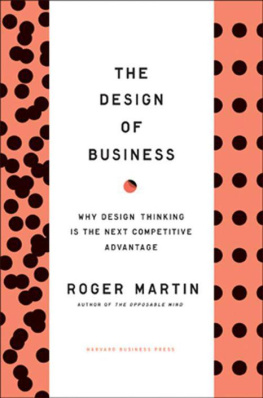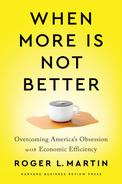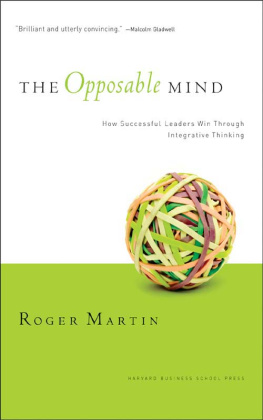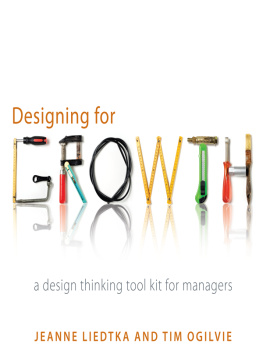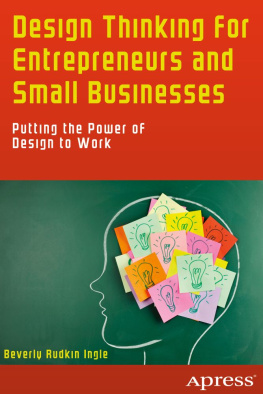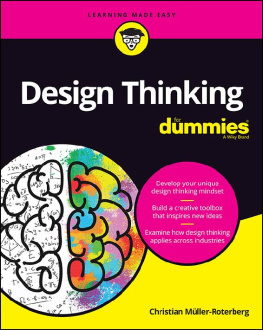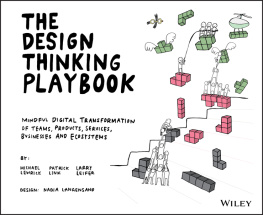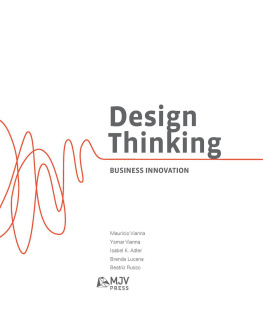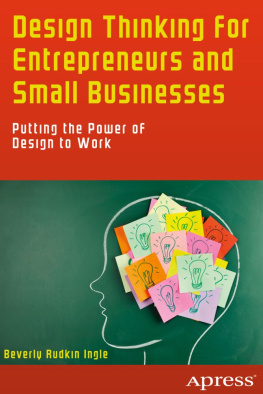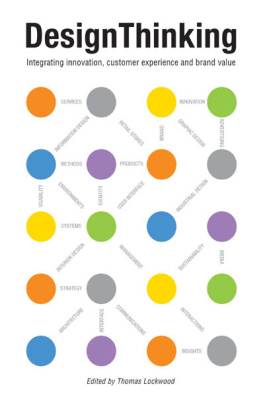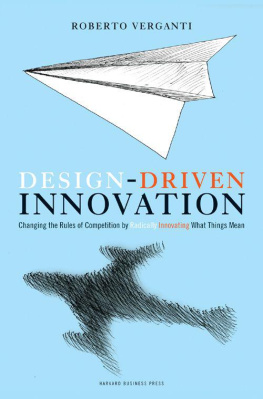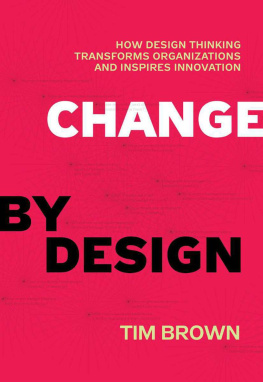Hunches, Heuristics, and Algorithmics: A Quick Note and Reliability Versus Validity: A Note on Prediction Copyright 2009 Mihnea Moldoveanu.
Why Youve Never Heard of Charles Sanders Peirce, Building a Design Thinking Organization from Within, and Wicked Problems Copyright 2009 Jennifer Riel.
Copyright 2009 Roger Martin
All rights reserved
First eBook Edition: October 2009
ISBN: 978-1-422-17780-8
Dedicated to Jennifer
Contents
| How Discovery Takes Shape |
| Why Advancing Knowledge Is So Hard |
| How Thinking Like a Designer Can Create Sustainable Advantage |
| The Design of Procter & Gamble |
| How Design-Thinking Organizations Embrace Reliability and Validity |
| Leading the Design-Thinking Organization |
| Developing Yourself as a Design Thinker |
I have many generous friends and colleagues to thank for their help on this book. In particular, I would like to thank and recognize three intellectual partners: Hilary Austen, Mihnea Moldoveanu, and Jennifer Riel.
Hilary Austen has had a profound influence on the way I think about design. The model for building ones personal design capability, which is outlined in , is based directly on Hilarys work on artistry. I am thrilled that she is (finally) capturing her brilliant work in a book, tentatively titled Artistry: How to Achieve and Enjoy Great Performance. I believe that it has a chance to be the best book on artistry since John Deweys 1934 masterpiece, Art as Experience.
Mihnea Moldoveanu, director of the Desautels Centre for Integrative Thinking, has been my closest and most important thinking partner since he joined me at the Rotman School a decade ago. We collaborate on numerous projects, and very little that I write cannot be traced back to one of our many conversations. You will see his insightful sidebars at various points in the book. I am particularly indebted to Mihnea for introducing me to the wonderful work of Charles Sanders Peirce, who is sufficiently obscure that only a polymath like Mihnea would have discovered his potential contribution to our work.
Jennifer Riel, who is associate director of the Desautels Centre, played the primary editing and research role on this book. She became ever more centrally involved in its evolution over the past year. Her advice was enormously helpful, her editing shaped and improved the book, and her discipline ensured that the manuscript met every deadline. You will see Jennifers nicely crafted sidebars at various points.
I would also like to thank three people who let me interview them extensively. Claudia Kotchka, a dear friend and Procter & Gambles first vice president of the figures in this book, including The Knowledge Funnel. The third vice president of innovation strategy and design, gave me lots of time and insights and also provided detailed feedback on the first manuscript of the book. Mike Lazaridis, founder of Research In Motion, creator of the ubiquitous BlackBerry, and one of the busiest people I have ever met, was very generous with his time and thoughts. Dr. Stephen Scherer, a world-renowned geneticist at the Hospital for Sick Children, not only let me interview him but gave me an extensive tour of his laboratory. What an eye-opener that was!
The primary financial supporter of my work in integrative thinking and design is my wise and far-thinking friend Marcel Desautels. Without his support and devotion, DesignWorks would have been one project, not a vibrant research and action-learning center. I would also like to thank Heather Fraser, the terrific leader I hired to head Rotman DesignWorks. She has done a wonderful job of building DesignWorks and furthering both the intellectual development and the practical application of the concepts in this book.
My designer friends were helpful and generous. Tim Brown and David Kelley of IDEO and Sohrab Voussoughi of Ziba answered a series of questions for me; their insights are dotted throughout. Bill Buxton of Microsoft and John Maeda, president of Rhode Island School of Design, did likewise and in addition reviewed the draft manuscript for me.
Deep in my past, three people strongly influenced my interest in design in business, and I probably would not have written this book without them. The husband and wife team of Bob Hambly and Barb Woolley (of the design firm Hambly & Woolley) have been my friends for twenty-five years and first got me interested in design. They played an important role by inviting me to be a keynote speaker for a 2003 design conference, which created an excuse to organize my thinking on design into a talk I called The Design of Business. It went over so well at the conference that I was motivated to write an article by the same name based on the conference presentation. Shockingly to me, publications from over a dozen countries saw the article in Rotman Magazine and asked permission to republish it in their country (and language). The high demand for the article encouraged me to write the book. So without Bob and Barb, I am not sure this book would have happened. By the way, Bob and Barb designed a number of the figures in this book, including The Knowledge Funnel. The third important influence is Rob Harvey, whom I met in 1993 when he was the senior vice president of design at Herman Miller. He was so passionate about design that he made it impossible for me to ever think again in the traditional ways I had thought about business.
I am fortunate to have a wonderful group of friends who reviewed the draft manuscript and gave helpful comments. First and foremost was Malcolm Gladwell, whose three-thousand-word critique was a thing of beauty and dramatically altered the structure of the bookfor the better to be sure. In addition to those already mentioned, I received helpful reviews from Brendan Calder, Melanie Carr, Delaine Hampton, Bruce Kuwabara, A. G. Lafley, Sally Osberg, Filippo Passerini, Joe Rotman, Suzanne Spragge, Patrick Whitney, and Craig Wynett.
Jennifer Riel and I also got valuable research help from Sean Forbes, Signy Franklin, Albert Ko, and Mark Leung.
I got fabulous help and support for my writing at the Rotman School. Karen Christensen, who publishes our wonderful Rotman Magazine, jumped on the design theme early and encouraged me to write several design articles for the magazine, pieces of which found their way into the book. Steve Arenburg and Ken McGuffin in media relations and events provided opportunities for me to write about design in business in publications such as Fast Company and BusinessWeek and speak at conferences in New York, San Francisco, Hong Kong, and London. Each time I wrote or spoke about design, I got feedback that helped me refine my thinking. And when I took off the summers of 2007 and 2008 to write, my great vice deans Jim Fisher and Peter Pauly and stellar chief operating officer Mary-Ellen Yeomans ran the school so efficiently that no one noticed I was gone!
This is my second book with Jeff Kehoe and his terrific team at Harvard Business Press. It was wonderful to work with Jeff a second time. I appreciated both his advice and his support through the books long gestation. It is my second collaboration with editor Harris Collingwood, who also worked on The Opposable Mind. Harris was a delight to work witha consummate writing professional whose instinct to shorten and simplify everything I write is well placed.
Last, but certainly not least, I want to thank the incomparable Tina Bennettuber agent. I owe my book publishing career (such as it is) to this talented woman. She helps shape each project to make it exciting for the publishers and makes everything move like clockwork. I look forward to many more collaborations with Tina.

